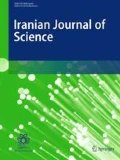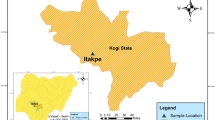Abstract
Lead and zinc ores are the most important natural raw materials widely used in the industry. These types of ores contain different amounts of radionuclides that expose workers to radiation during extraction, transport, and processing. In this study, 22 samples were collected, including 18 samples of lead–zinc ore and 4 samples of mining waste. Specific activities of 226Ra, 232Th, and 40K were determined using a high-purity germanium gamma radiation detector (HPGe). The specific activities of corresponding radionuclides in lead–zinc ore samples varied in the range (< 0.21–107.61), (1.91–48.13), and (< 10.16–664.04) in Bq/kg, respectively. According to the European Commission’s dose assessment instruction for workers, the effective dose absorption was calculated for different scenarios, as transport, outdoor storage, and internal storage, which varied from 0.76 to 10.23 µSv/y, 1.05–17.00 µSv/y, and 1.20–19.20 µSv/y, respectively. For all lead–zinc ore samples, effective doses in various scenarios were lower than the intervention level (1.0 × 103 μSv/y) determined by the International Commission on Radiological Protection.


Similar content being viewed by others
References
Behbahani SS, Moarefvand P, Ahangari K, Goshtasbi K (2013) Unloading scheme of Angooran mine slope by discrete element modeling. Int J Rock Mech Min 64:220–227. https://doi.org/10.1016/j.ijrmms.2013.08.018
Dahooei AH, Heidari A et al (2016) Identification of mineralized zones in the Zardu area, Kushk SEDEX deposit (Central Iran), based on geological and multifractal modeling. Open Geosci 8(1):143–153
Davidson A, Ryman J, Sutherland CA, Milner EF, Kerby RC, Teindl H et al (2014) Lead. Ullmann’s Encyclopedia of Industrial Chemistry
EC European Commission (2002) Practical use of the concepts of clearance and exemption (Part II). EC, Belgium
Firestone RB, Shirley VS, Baglin CM (1996) Table of isotopes CD-ROM. Eight Edition Version
Gilmore M (2008) Practical gamma ray spectrometry, 2nd edn. Wiley, New York. https://doi.org/10.1002/9780470861981
IAEA (2004) Application of the Concepts of Exclusion, Exemption and Clearance, Safety Standards Series No. RS-G-1.7. International Atomic Energy Agency, Vienna
IAEA-TECDOC-1360, (2003) Collection and preparation of bottom sediment samples for analysis of radionuclides and trace elements. International Atomic Energy Agency, Vienna
ICRP (1999) Protection of the Public in Situations of Prolonged Radiation Exposure, ICRP Publication, vol 82
Iwaoka K, Tagami K, Yonehara H (2009) Measurement of natural radioactive nuclide concentrations in various metal ores used as industrial raw materials in Japan and estimation of dose received by workers handling them. J Environ Radioact 100(11):993–997. https://doi.org/10.1016/j.jenvrad.2009.08.004
Lead and Zinc Statistics (2000) Monthly bulletin of the international lead and zinc study group. vol 4, no 8
Live Chart of Nuclides nuclear structure and decay data ms: 1978 Available from: https://nds.iaea.org/relnsd/vcharthtml/VChartHTML.html
Long S, Sdraulig S, Tate B, Martin P (2012) A survey of naturally occurring radioactive material associated with mining. Technical Report Series No. 161. Australian Radiation Protection and Nuclear Safety Agency. ISSN: 0157-1400
Mokhtari AR, Feiznia S, Jafari M, Tavili A, Ghaneei-Bafghi MJ, Rahmany F et al (2018) Investigating the role of wind in the dispersion of heavy metals around mines in arid regions (a case study from Kushk Pb–Zn Mine, Bafgh, Iran). B Environ Contam Tox 101:124–130. https://doi.org/10.1007/s00128-018-2319-3
Nguyen DC, Khanh PL, Jodlowski P, Pieczonka J, Piestrzynski A, Van HD et al (2016) Natural radioactivity at the Sin Quyen Iron-Oxide-Copper-Gold deposit in north Vietnam. Acta Geophys 64(6):2305–2321. https://doi.org/10.1515/acgeo-2016-0103
Pourimani R, Anoosheh F (2015) A study on transfer factors of environmental radionuclides: radionuclide transfer from soil to different varieties of rice in Gorgan, Iran. Iran J Med Phys 12(3):189–199. https://doi.org/10.22038/IJMP.2015.6220
Pourimani R, Azimi HR (2016) Gamma spectrometric analysis of iron ore samples of Arak, Iran. Iran J Med Phys 13(3):174–182. https://doi.org/10.22038/IJMP.2016.7961
Pourimani R, Davoodmaghami T (2018) Radiological hazard resulting from natural radioactivity of soil in East of Shazand Power Plant. Iran J Med Phys 15(3):192–199. https://doi.org/10.22038/IJMP.2018.26655.1272
Preparation and Certification of IAEA gamma-ray Spectrometry Reference Materials RGU-1, RGTh-1 and RGK-1, IAEA/RL/148, August (1987)
Singh P, Rana NPS, Azam A, Naqvi AH, Rivastava DS (1996) Levels of uranium in water from some Indian cities determined by fission track analysis. Radiat Meas 26(5):683–687. https://doi.org/10.1016/S1350-4487(97)82882-X
Todorovic D, Jankovic M, Nikolic J, Kosutic DD (2012) Radioactivity of mining sites of lead, zinc and phosphate ores in Serbia. J Environ Sci Health A 47(6):812–817. https://doi.org/10.1080/10934529.2012.664992
UNSCEAR (2010) Sources and effects of ionizing radiation. Rep General Assembly Sci Annex 1:1–219
UNSCEAR (United Nations Scientific Committee on the Effects of Atomic Radiation) (1993) Sources and effects of ionizing radiation report to general assembly with scientific Annexes. United Nation Publication, New York
UNSCEAR (United Nations Scientific Committee on the Effects of Atomic Radiation) (2008) Sources and effects of ionizing radiation report to general assembly with scientific Annexes. United Nation Publication, New York
Yaghubpur A, Mehrabi B (1997) Kushk Zinc-Lead deposit, a typical black-shale-hosted deposit in Yazd state. Iran. J Sci I R Iran 8:117–125
Acknowledgements
This work has been funded by the research councils of Yazd and Arak Universities, so the authors are grateful. The authors also thank the staff and the management of the Yazd zinc–lead mine.
Author information
Authors and Affiliations
Corresponding author
Ethics declarations
Conflict of interest
The authors did not declare a conflict in the preparation of this work.
Rights and permissions
About this article
Cite this article
Tatari, M., Pourimani, R., Meimandi, S.M. et al. Risk Assessment of Natural Radionuclide Contamination in Lead–Zinc Sulfide Ores Mining. Iran J Sci Technol Trans Sci 45, 383–389 (2021). https://doi.org/10.1007/s40995-020-01038-4
Received:
Accepted:
Published:
Issue Date:
DOI: https://doi.org/10.1007/s40995-020-01038-4




